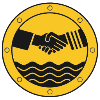
Gladstone was the first port to apply to join the ISWAN pilot project and agree to establish an inaugural local welfare board in this important project.
Managed by Gladstone Ports Corporation (GPC), a government-owned organisation, the port covers a large area and is a natural deep water harbour sheltered by islands. The port is a major exporter of minerals and one the world’s largest export coal terminals. Gladstone is an expanding port that has also recently developed world class LNG terminals at Wiggins Island. Each year around 2,000 ships arrive at one of its 8 main terminals and this is expected to increase significantly when the new LNG terminals reach full capacity.
It is estimated that already around 40,000 seafarers transit the port annually with their ships normally alongside for between 24 to 36 hours, usually before and after a long voyage at sea, often taking many weeks. Vessels may also spend many days at anchor, awaiting a berth, before entering port. With small crew numbers and tight watch systems, seafarers usually have very limited time ashore to enjoy port welfare facilities.
Fortunately the port boasts an excellent seafarers’ centre, operated by the Mission to Seafarers and supported by GPC. This provides a retail shop, money exchange, low cost money transfer, free internet and computers, an interdenominational chapel and very importantly counselling and support to those seafarers needing pastoral care. The charity also provides free port transportation and ship welfare visits, which are highly regarded by seafarers and the port community alike.
The Gladstone Port Welfare Committee was established in accordance with recommendations set out in the ILO’s Maritime Labour Convention (MLC) 2006. The inaugural meeting took place in July 2015, attended by representatives of the state and local government, port authority, trade unions, shipping agents and voluntary organisations from the port and across the region. Short introductions were given by the Project Manager, Peter Tomlin and Mission to Seafarers representatives Rev Russell Cunningham (Port Chaplain) and Mr Dennis Anderson (Seafarers Centre Manager) at the start of the meeting, which were all well received. The minutes of the inaugural meeting were produced in a standardised format the following day and Gladstone PWC have agreed the dates of their next meetings.
Much of the success of the inaugural meeting was attributable to sound preparation. Key to this was the co-ordinating role played by Captain Gary Wilson, GPC Marine Operations General Manager who had met twice with the maritime community to discuss the project. The newly formed Committee selected ex harbour master Captain Mike Lutz and Peter Jones (representing the shipping agents) as Chairman and Vice Chairman, respectively.
The project is managed, on behalf ISWAN, by the UK’s Merchant Navy Welfare Board, which has experience of managing port welfare committees since 1948. Subsequently the Project Manager, Mr Peter Tomlin, said how pleased and impressed he was with the local support and enthusiasm, adding that he believed that this was great example of people from all parts of the maritime community working together with one common aim, that of supporting seafarers.
The Gladstone Port Welfare Committee is expected to make a valuable contribution to seafarers’ welfare on a local level and link to the Australian Seafarers’ Welfare Council (ASWC) at the national level.